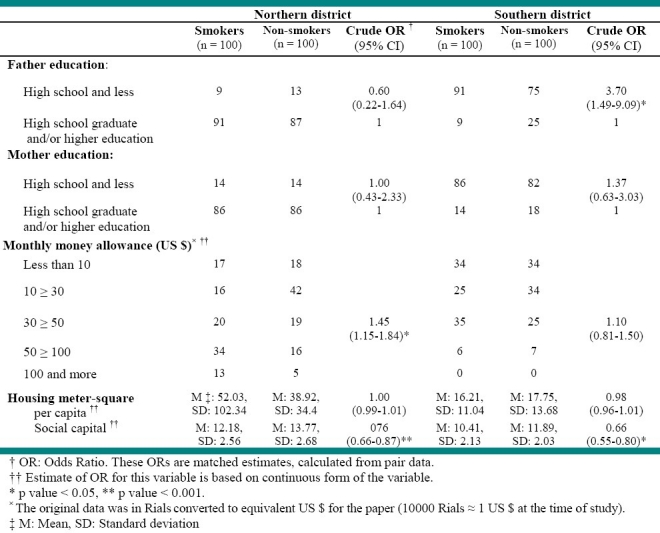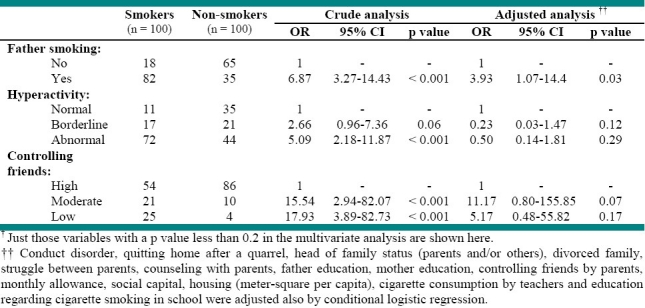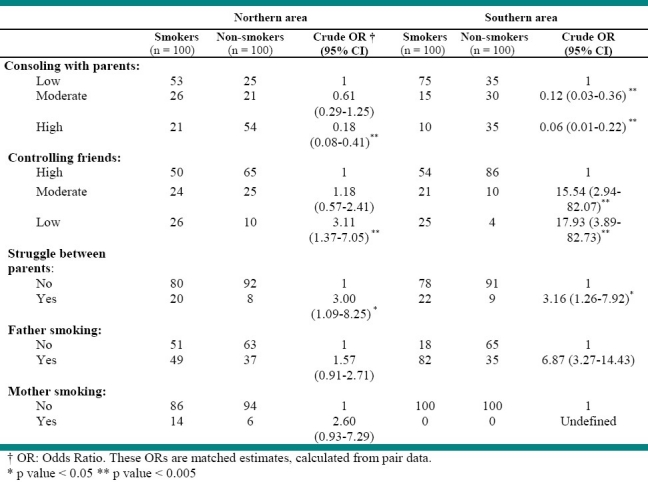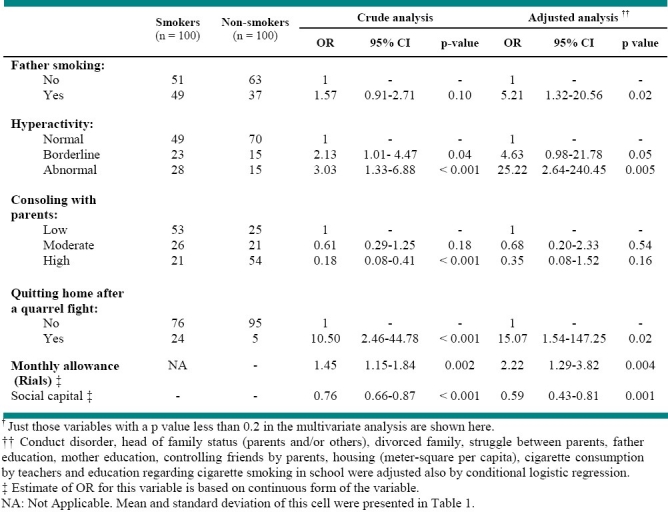Abstract
Objectives:
Identifying the underlying factors contributing to smoking among teenagers is important in establishing smoking control programs. The present study was designed to identify and compare factors revealed in a preceding qualitative study conducted on 13-15 year-old boys living in two different socio-economic districts in the Northern and Southern parts of Tehran.
Methods:
Two completely similar case-control studies, each with 200 subjects, were conducted using a snowball sampling. The case and control subjects were matched based on the intimacy relations, i.e. six smokers were recruited in each of the Northern and Southern districts; they were then asked to introduce one of their smoker friends as a case and a non-smoker one as a control.
Results:
Multi-variable conditional logistic regression revealed that having a smoker father is the single effective factor in the two districts. As for boys living in the Northern (wealthier) part of the city, social capital (OR: 0.59, 95% CI: 0.43-0.81) played a protective role against smoking, whereas quitting home after a quarrel (OR: 15.07, 95% CI: 1.54-147.25), monthly allowance (OR: 2.22, 95% CI: 1.29-3.82) and hyperactivity (OR: 1.69, 95% CI: 2.64-240.45) were associated with a higher risk of becoming a smoker.
Conclusions:
The studied variables can be classified as personal, familial, and school-level factors. Familial intervention is effective for all the factors which revealed to be influential on the risk of becoming a smoker. It could be concluded that interventions on the family level should be used to prevent the cigarette use in Tehran.
Keywords: Smoking, Teenagers, Male, Snowball sampling
INTRODUCTION
Global use of tobacco is considered as a “pediatric disease” and “pediatric epidemia”.1 Many foresee that the continuation of the current trend of tobacco use would lead to the death of more than 250 million children and adolescents, particularly in the developing countries. Statistics have shown that more than 10% of students aged between 13 and 15 years use tobacco.2 About 4000 children start smoking each day, whereas 1500 of the adolescents aged less than 18 years are regular smokers. Some 545000 youngsters become smokers annually and one-third of them are believed to die due to tobacco use. Based on the report released by the US Centers for Disease Control and Prevention, about 6 million of the children would die because of smoking-related conditions later on in life.3 A considerable increase has been noted in the prevalence of smoking among young males.4 While the smoking epidemic and related mortality is commonly confined to adults, the main problem starts from the childhood. It is far from belief that an individual who had never smoked during his adolescence would start smoking in the long run.5
Considering the fact that many people start smoking in young ages, long-term addiction to nicotine is common. Moreover, the use of smoke-free tobacco or cigarettes as the first used drug may contribute to the chronic use of tobacco, alcohol, marijuana and other hard drugs among adolescents.6 The above mentioned association points out the importance of identifying the main reasons contributing to smoking among teenagers. As a result, many cross-sectional studies have been conducted in different parts of the world to spot these factors.7
According to a report released by the World Health Organization, Eastern Mediterranean Region Office, the prevalence of smoking in Iranian students aged between 13 and 15 years has increased from 12% in 2003 to 27% in 2007.8 This finding is in agreement with the report of a national study that showed 13.4 and 8.1 percent of boys and girls, respectively, to be cigarette smokers in Iran.9 On the other hand, a study has reported that 31% of the male high school students smoke on a daily basis in Tehran.10 All aforementioned studies show the problem of cigarette smoking in teenagers, especially in males, to be an important health issue. The present study was, therefore, designed to identify the main underlying causes of tobacco use in this population in an act to point out the main risk factors contributing to the smoking habit. In a previous qualitative study, we recognized the factors influencing the tendency of male teenagers in Tehran toward tobacco use.11
The present study aimed to assess the factors identified in that study in a quantitative manner. It also tried to determine the effect of each factor on tobacco use among teenagers and to point out whether the socio-economic context influences these effects.
METHODS
In order to compare the socio-economic context of the two districts located in the Northern and Southern areas of Tehran (namely 1st and 17th districts, the best and worst districts in Tehran, respectively), the dimensions of the living space was defined as the proxy for determining the economic status in Tehran.12
The matched case-control study was conducted on 200 male students aged between 13 and 15 years from Northern district of Tehran along with 200 others from the Southern district. The cases and controls were selected through a snowball sampling, a technique used to study subjects from a hidden population who use illegal drugs. Six individuals were selected from the Northern and Southern neighborhoods of Tehran as the seeds. They were not recruited in the study. Each subject was then asked to name two of their friends, a smoker (who had been smoking regularly or often in the past month) and a non-smoker (who had never smoked), until 100 cases were recruited in each of the Northern and Southern parts of Tehran. Another paper from smoker cases of this study was prepared to assess the pattern of smoking and its onset age.13 The tree for study subjects recruitment was ended in case the individual could not introduce anyone. A gift was given to all the individuals who were recruited in the study. Having communication problems was the only exclusion criteria for the study.
Data gathering tool was a questionnaire including demographic data and information on the family's socio-economic status, social capital, the severity of family control on the teenager, teachers’ cigarette consumption, education regarding smoking in the school and personal history of psychological and hyperactivity/attention deficit disorders. Social Capital consists of a group of factors including confidence, norms and networks which can improve the social function through synchronizing the condition. In the present study, social capital comprised seven features including trusting the first- and second-degree family members, friends, neighbors and local residents, being satisfied with the living place and feeling relaxed in it. The questions on social capital included seven inquiries regarding trust issues and satisfaction with the living place, adapted from a study on the same age group in Iranian population.14
The psychological disorders included conduct disorder (ranging from antisocial behaviors such as aggressiveness, robbing, destruction, putting somewhere on fire on purpose, telling a lie, wandering and escaping) and hyperactivity disorders. In order to assess the severity of possible psychological disorders, a Farsi version of Strengths and Difficulties Questionnaire (SDQ) was used.15 Based on the total scores, the subjects were classified in three main groups: suspicious, normal and abnormal. The reliability of the questionnaire was checked using a test-retest conducted within a 2-week interval on 20 subjects in a pilot study. The intracluster correlation was reported to be 79%.
Considering the fact that the smoker and non-smoker friends of an individual were considered as the matched pair, individual matching analysis and subsequent conditional logistic regression were performed. The use of snowball sampling technique, however, makes the case and control dependent on each other, increasing the risk of over-matching in the population. In other words, the friendship between the case and control pronounces their much the same characteristics (such as being involved in high-risk behaviors) and reduces the chance of detecting effective factors. There are two different sampling approaches in such snowball sampled case-control studies. In the first, which was used in several researches conducted in the field of drugs, the first interviewed case is asked to introduce two of their friends, another case and a control. The non-case friend is considered as the paired match control for the first interviewed case.16 In the second method, which was used in this study, the smoker and non-smoker friends of the first interviewed subject are considered as the case and control; the first seed smoker is excluded from this pair, and their information is gathered for subsequent pair-matched analysis. The later approach might have less dependency between the matched pairs, since they are indirectly correlated to each other through the first case interviewed.
The present study was approved by the Ethics Committee of Tehran University of Medical Sciences. The questionnaires were anonymous and did not highlight the individuals’ identity.
RESULTS
Tables 1 to 5 demonstrate the results. Since a hundred cases and controls were recruited in each one of the Northern and Southern series, the cells of the tables show the frequencies both in numbers and percentages. The other point is that while the tables consist of frequency of observations in case and control groups, the crude odds ratios (Ors) are not estimated directly from these observations and are calculated upon individual pair matches.
Table 1.
Socio-economic characteristics and social capital of the case and control families

Table 5.
Crude and adjusted effect of independent variables on smoking of teenagers in the Southern district of Tehran†.

Table 1 compares not only the baseline information in each case and control series, but also the socio-economic status of inhabitants living in the two districts from the Northern and Southern Tehran. It was revealed that a “higher than high school” maternal education level existed in about 86 and 18 percent of the teenagers living in the Northern and Southern areas, respectively. Similarly, while the fathers of about 87 percent of the teenagers from Northern parts of the city had higher education, only 25 percent of the fathers of those living in the Southern parts had completed their high school and/or continued to higher education. Comparing the mean allowance of teenagers in the two districts also revealed a significant difference (41$ vs. 24$ in Northern and Southern areas, respectively).
Tables 2 and 3 show the family control measures and the psychological disorders in the studied population. Comparing the controls of the two districts revealed the fact that family control in the Northern areas is confined to consulting with parents (75% moderate to high consultation), whereas controlling friends (96% moderate to high) was the main issue in the families living in the Southern neighborhood. Psychological disorders, on the other hand, were significantly frequent in the two districts (conduct disorder: 46 and 76%; hyperactivity: 15 and 44% in the Northern and Southern districts, respectively). Crude Ors show a significant difference between cases and controls in hyperactivity in the both districts.
Table 2.
Comparison of family control measures according to district and case-control groups in 13 to 15-year-old teenagers

Table 3.
Comparison of psychological social disorders according to district and case-control groups in teenagers

Tables 4 and 5 point out the variables reported to have a p value lower than 0.2 in one of its levels. Cigarette consumption by teachers and education regarding cigarette smoking did not show significant effect in both crude and adjusted analysis (not shown in the tables) and are adjusted with other covariates in conditional logistic regression. Reporting the influence of having a smoker father, which increased the risk of becoming a smoker by 5 and 4 times in the Northern and Southern districts, respectively, was the main common point of the two case control series.
Table 4.
Crude and adjusted effect of independent variables on smoking of teenagers in the Northern district of Tehran†.

The magnitude of effect of hyperactivity on smoking habits among teenagers of the Northern areas of the city was also noted (OR higher than 25 while comparing normal and abnormal cases; p < 0.005). However, this variable had a smaller magnitude of effect and a non-significant p value (p = 0.2) among teenagers living in the Southern areas.
Other factors outlined in Table 4 only had a significant influence on the smoking habits of teenagers living in the Northern districts. Every increase one point in social capital was associated with 0.59 times higher chance of becoming a smoker, indicating that social capital has a protective role against becoming involved in the habit (p < 0.001). There was a significant association between quitting home after a quarrel and smoking (p < 0.001). Teenagers who had left home after having a quarrel with their parents were 15 times more likely to smoke.
The allowance was considered as a risk factor as the teenagers who received more pocket money were placed at a greater chance of becoming a smoker. Consulting with parents was noted in 21% of the smokers and 54% of the non-smokers; there was a significant difference between the amounts in the crude analysis (p < 0.001) but not the adjusted ones.
Table 5 lists the variables affecting the chance of teenagers from the Southern districts to become a smoker. Two of these variables were discussed previously. Parental controlling the friends of their son was noted in 54% of the smokers and 86% of the non-smokers. There was a significant association between controlling the teenagers and their chance of becoming a smoker in the crude analysis. In the multivariable analysis, however, the p value was as high as 0.07, which shows a high magnitude of effect despite not being statistically significant.
DISCUSSION
The present study reported that social capital, the history of quitting home after a quarrel, having a smoker father, being hyperactive and receiving more allowance are the main factors influencing the risk of becoming a smoker in teenagers living in the Northern parts of Tehran. As for those living in the Southern districts, however, having a smoker father was the only factor influencing the association.
Several studies have assessed the prevalence of smoking among teenagers and the factors influencing the association. To our knowledge, however, none of these studies have simultaneously investigated personal psychiatric status (conduct disorder and hyperactivity), family socio-economic status, parental control, school condition (teacher as the role model and school education programs regarding smoking) and social capital. In other words, the present study was based on a preceding qualitative study which assessed smoking habit among teenagers according to the point of view of various stakeholders including teenagers, parents and pediatric psychiatrics.11 This is the reason that a range of the variables are targeted in the present study.
The used snowball sampling technique and the case control nature of the study were suitable for collecting the required subjects. Considering the fact that smoking among 13-15 year-old teenagers is socially undesirable, the above mentioned study design was used to detect the covered population, i.e. the nature of the study improved the trust issues and the participation of the subjects.
As Table 1 shows, there was no significant difference between the socio-economic status of the cases and controls recruited from each one of the studied districts, indicating that the snowball sampling technique has succeeded to find identical cases and controls from the target population. Therefore, such a sampling technique has also shown promising results in recruiting case and control samples from the same study bases.17
The crude results in Tables 3–5, indicating the multivariable analysis, revealed that conduct disorders, hyperactivity and quitting home after a quarrel are important factors affecting smoking habit among teenagers. However, hyperactivity was identified as the only significant factor in adjusted analysis affecting the smoking among teenagers living in the Northern districts. Similarly, Rhode et al. reported a positive association between hyperactivity and smoking.18 While proving the cause and effect relation between hyperactivity and smoking has some limitations, the exploratory nature of the present study suggests that on-time screening for hyperactivity can be an effective intervention for probing those who are at risk of smoking. This interpretation is in accordance with the epidemiology concept that the case-finding based on an identified association has advantages even if the relationship is distorted by the confounders.19
The present study reported a positive correlation between having a smoker father and the formation of a smoking habit among teenagers in both Northern (OR: 5.21, 95% CI: 1.32-20.56) and Southern (OR: 3.93, 95% CI: 1.07-14.4) neighborhoods. Other studies have similarly reported that having a smoker family member, particularly parents, can increase the risk of smoking among teenagers.20 Having a smoker sibling or more than one smokers in the family has also been linked with the increased risk of becoming a smoker.10 Considering this finding, it could be concluded that empowerment of families and reducing the use of cigarettes among family members can help tackle the smoking habit among teenagers. Other familial behaviors were also reported to have a positive effect on teenagers’ smoking habit. Tables 4 and 5 showed the positive influence of consulting with parents in Northern areas and controlling the teenagers’ relation with their friends in the Southern parts on the habit in the crude analysis but not the adjusted ones.
On the contrary to the Southern areas (OR: 0.29, 95% CI: 0.03-2.93), quitting home after a quarrel was reported to have a positive effect in teenagers living in the Northern districts (OR: 15.07, 95% CI: 1.54-147.25). Other studies have also considered having a quarrel between parents and children and displaying aggression at home to influence the risk of becoming a smoker during adolescence.21 Family conflict is another factor that makes children leave the house, placing them at a greater risk of becoming a smoker. As a result, empowerment of parents regarding problem solving techniques with their children can help them solve possible conflicts.
Previous studies have pointed out the correlation between smoking and the amount of pocket money22 and the family's income.23,24 The present study could only reveal a positive relation between allowance and smoking in the Northern district (OR: 2.22, 95% CI: 1.29-3.82). The low significance of the relation in the Southern areas might be due to the low variance in this part of the city.
The social capital was the only factor significantly protecting the teenagers living in the Northern Tehran against becoming a smoker (OR: 0.59, 95% CI: 0.43-0.81). In the Southern parts, however, such an association was not noted. In a Swedish study, a similar association was reported between social capital and smoking. In the previous study, high confidence was associated with a 0.06 times lower risk of becoming a smoker.24
CONCLUSION
Having a smoker father is the only common risk factor influencing smoking habit in both Northern and Southern areas. The importance of the topic is more pronounced when the study revealed having a smoker father as the only factor affecting smoking in the Southern districts. The possible role of parents in influencing smoking habit and in deepening the social capital (the only protective factor in the Northern areas of Tehran), identifying and treating hyperactivity on time, accurately managing the family struggles (effective in preventing quitting home following a conflict) and providing teenagers with sufficient pocket money points out their critical role in the rate of smoking among teenagers. Family interventions are, therefore, recommended to prevent the habit.
Footnotes
Conflict of interest statement: All authors declare that they have no conflict of interest.
Source of funding: This project was financially supported by Vice Chancellor of Research of Tehran University of Medical Sciences (Project No. 5749, 86-02-27)
REFERENCES
- 1.Perry CL, Eriksen M, Giovino G. Tobacco use: a pediatric epidemic. Tob Control. 1994;3(2):97–8. [Google Scholar]
- 2.World Health Organization. Tobacco Free Initiative (TFI), About youth and tobacco. [cited 2011 Mar 30]. Available from: URL: http://www.who.int/tobacco/research/youth/about/en/index.html .
- 3.Campaign for Tobacco- Free kids. Tobacco Harm to Kids. [cited 2011 Mar 30]. Available from: URL: http://www.tobaccofreekids.org/facts_issues/fact_sheets/
- 4.Peto R. Smoking and death: the past 40 years and the next 40. BMJ. 1994;309(6959):937–9. doi: 10.1136/bmj.309.6959.937. [DOI] [PMC free article] [PubMed] [Google Scholar]
- 5.Kessler DA. Nicotine addiction in young people. N Engl J Med. 1995;333(3):186–9. doi: 10.1056/NEJM199507203330311. [DOI] [PubMed] [Google Scholar]
- 6.Atlanta, Georgia: Public Health Service, Centers for Disease Control and Prevention (CDC); 1994. U.S. Department of Health and Human Services. Preventing Tobacco Use among Young People, A Report of the Surgeon General, Executive Summary. [Google Scholar]
- 7.Tobacco use among youth: a cross country comparison. Tob Control. 2002;11(3):252–70. doi: 10.1136/tc.11.3.252. [DOI] [PMC free article] [PubMed] [Google Scholar]
- 8.World Health Organization. Trends in tobacco use among school students in the Eastern Mediterranean Region. [cited 2011 Mar 30]. Available from: URL: http://www.emro.who.int/tfi/PDF/Tobacco%20_among_school_students.pdf .
- 9.Kelishadi R, Ardalan G, Gheiratmand R, Majdzadeh R, Delavari A, Heshmat R, et al. Smoking behavior and its influencing factors in a national-representative sample of Iranian adolescents: CASPIAN study. Prev Med. 2006;42(6):423–6. doi: 10.1016/j.ypmed.2006.03.001. [DOI] [PubMed] [Google Scholar]
- 10.Heydari G, Sharifi H, Hosseini M, Masjedi MR. Prevalence of smoking among high-school students of Tehran in 2003. East Mediterr Health J. 2007;13(5):1017–21. doi: 10.26719/2007.13.5.1017. [DOI] [PubMed] [Google Scholar]
- 11.Rezaei F, Majdzadeh R, Nedjat S, Golestan B. Motives for cigarette smoking in 13- to 15-year-old boys: A qualitative study. Journal of School of Public Health and Institute of Public Health Research. 2007;5(4):25–33. [Google Scholar]
- 12.Hadipoor HKH, Farhoudi RA, Pourahmad A. Efficient criteria for delimitation of urban regions, a case study: Region one of Tehran Municipality. Geographical Research Quarterly. 2006;38(57):93–111. [Google Scholar]
- 13.Rezaei F, Nedjat S, Golestan B, Majdzadeh R. Comparison of onset age and pattern of male adolescents smoking in two different socioeconomic districts of Tehran. Int J Prev Med. 2011 In Press. [PMC free article] [PubMed] [Google Scholar]
- 14.Moosavi Khamene M. Tehran: The University of Tehran; 2004. Social capital and social conduct: A survey on social capital in high schools; its effect on the students’ social conduct. PhD Thesis in Social Science. [Dissertation] [Google Scholar]
- 15.Ghanizadeh A, Izadpanah A. Scale Validation of the Strengths and Difficulties Questionnaire in Iranian Children. Iranian J Psychiatry. 2007;2(2):65–71. [Google Scholar]
- 16.Lopes CS, Sichieri R. A case-control study on alcohol and psychiatric disorders as risk factors for drug abuse pattern. Cad Saude Publica. 2002;18(6):1571–5. doi: 10.1590/s0102-311x2002000600010. [DOI] [PubMed] [Google Scholar]
- 17.Wacholder S, McLaughlin JK, Silverman DT, Mandel JS. Selection of controls in case-control studies. I. Principles. Am J Epidemiol. 1992;135(9):1019–28. doi: 10.1093/oxfordjournals.aje.a116396. [DOI] [PubMed] [Google Scholar]
- 18.Rohde P, Lewinsohn PM, Brown RA, Gau JM, Kahler CW. Psychiatric disorders, familial factors and cigarette smoking: I.Associations with smoking initiation. Nicotine Tob Res. 2003;5(1):85–98. doi: 10.1080/1462220031000070507. [DOI] [PubMed] [Google Scholar]
- 19.Szklo M, Nieto J. 2nd ed. USA: Jones and Bartlett Publishers; 2006. Epidemiology: Beyond the Basics. [Google Scholar]
- 20.Tercyak KP, Lerman C, Audrain J. Association of attention-deficit/hyperactivity disorder symptoms with levels of cigarette smoking in a community sample of adolescents. J Am Acad Child Adolesc Psychiatry. 2002;41(7):799–805. doi: 10.1097/00004583-200207000-00011. [DOI] [PubMed] [Google Scholar]
- 21.Kristjansson AL, Sigfusdottir ID, Allegrante JP, Helgason AR. Social correlates of cigarette smoking among Icelandic adolescents: a population-based cross-sectional study. BMC Public Health. 2008;8:86. doi: 10.1186/1471-2458-8-86. [DOI] [PMC free article] [PubMed] [Google Scholar]
- 22.Rissel C, McLellan L, Bauman A. Factors associated with delayed tobacco uptake among Vietnamese/Asian and Arabic youth in Sydney, NSW. Aust N Z J Public Health. 2000;24(1):22–8. doi: 10.1111/j.1467-842x.2000.tb00718.x. [DOI] [PubMed] [Google Scholar]
- 23.Sreeramareddy CT, Kishore P, Paudel J, Menezes RG. Prevalence and correlates of tobacco use amongst junior ollegiate in twin cities of western Nepal: a cross-sectional, questionnaire-based survey. BMC Public Health. 2008;8:97. doi: 10.1186/1471-2458-8-97. [DOI] [PMC free article] [PubMed] [Google Scholar]
- 24.Lundborg P. Social capital and substance use among Swedish adolescents; an explorative study. Soc Sci Med. 2005;61(6):1151–8. doi: 10.1016/j.socscimed.2004.12.031. [DOI] [PubMed] [Google Scholar]


